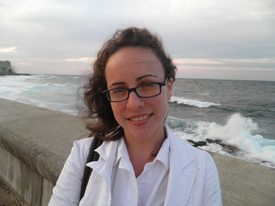CAA News Today
Lilianne Lugo: 2014 International Travel Grant Recipient
posted Apr 01, 2014
After last month’s Annual Conference, recipients of CAA’s 2014 International Travel Grants were invited to contribute short articles reflecting on their experiences in Chicago. What follows is a personal reminiscence from Lilianne Lugo, an educator, administrator, and playwright based in Havana, Cuba. Lugo studies the relationship between the history of art and the history of theater, as well as the intersections of contemporary art practice and the performing arts. She is professor and vice dean of research and postgraduate studies at the Universidad de las Artes in Havana, Cuba.
Saudade
The persistence of melancholy. The persistence of the friends I have released to oblivion. The persistence of the memories of other cities, other people that I miss. I walk in an unknown city. I can barely breathe, it’s so cold. My best friend wrote me an email. “What are you doing?” he asks. “I miss you….” But when I wrote him back I can only send him a picture of my foot on the snow … it’s my way of embracing the spirit of life, my way of saying that I am seizing and enjoying the opportunities that suddenly emerge in our lives and change it forever. Just a few moments in life can be counted like that, and this is one of them.
First time in the snow. From the plane I can see the frozen ground. Behind I have left the unbearable heat of Havana and the noise of its streets. First time in Chicago. First time in the United States. First time at CAA’s conference. So many impressions, so many new people. I can write only in first person singular. I can’t speak for the others. I can’t talk about what I haven’t seen before.
For a couple of days the Hilton Chicago is invaded by hordes of art historians, artists, professors, and recruiters. It’s a huge event, and the whole city seems to inhale a whirlwind of art. Exhibitions, talks, panels, and informal gatherings that interrupt the rhythm of daily routines and establish a different understanding of reality. In a world of white ground, how to conjure the fire of masterpieces? How can we understand and explain (if that’s possible) from a warm and carpeted hotel the always ungraspable world of art and art history?
For twenty people each year, the College Art Association and the Getty Foundation make it possible to attend this conference. That means twenty people in the world receive a gift to come to the States and share and learn what we know about the art in our countries with colleagues from all over the US. This time the group is composed of people from Egypt, Romania, Bulgaria, Russia, South Africa, Portugal, Poland, Cuba, Argentina, Chile, Brazil, Uganda, Ghana, Cameroon, Estonia, Pakistan, Malaysia, Bangladesh, Nigeria, and Croatia.
Some images of those days come to my mind: the day of the preconference, in which each of us presented a paper about our research, and the discussion afterward about so many different topics. Art Shay’s exhibition My Florence at the Museum of Contemporary Photography at Columbia College Chicago that we, as a group, visited together. In the library of the college we saw the photographs and the artist himself. It was the story of his life, the little moments he shared with his wife and family, and it was so impressive to see him, with the energy and look that only years can bring. Or the exhibition at the DePaul Art Museum, The Sochi Project: An Atlas of War and Tourism in the Caucasus, about the 2014 Winter Olympic Games in Sochi, Russia, and the environment of that particular area that, in the former days of Communism, was the recreational spot for Joseph Stalin. And then we walked with our graduate-student host to see the Lakeview neighborhood nearby. Or the meetings with so many bright and marvelous people….
Then, when the conference ended, another trip was waiting for us, to the Clark Art Institute in Massachusetts. From the plane’s window we could see Manhattan and the Statue of Liberty; at LaGuardia airport we said goodbye to our fellow travel-grant recipient Mahmuda Khnam, who was feeling sick and couldn’t travel to Williamstown. We talked on the drive north and shared our opinions, we talked about everything: Brazilian soap operas, LGBT rights, curatorial practices, communism, incomes, outcomes, food, and snow. Then, a warm welcome at the Clark, a very special place in a beautiful setting where studying takes place in real luxury. Outside it snowed all day long, but inside the Clark was joyful and cozy, as we were received in that sanctuary of knowledge like kings and queens.
Now, in the sun again, I remember with joy the city of Chicago, the museums, the extraordinary collection of the Art Institute, the people of CAA, my fellow grant recipients, and, of course, all that I have learned about not only specific issues related to my research, but also the methodologies and approaches that many colleagues are currently using. I learned, too, about how things work in the professional world of art and art history in the United States.
I began this essay talking about melancholy. It’s the feeling I get when I think about those moments during CAA’s conference. Portuguese had a beautiful word to describe it: saudade. And that would be the best word, because even in Spanish nostalgia or melancolía are not the same. I cherish those moments. While I am thinking about what lies ahead, I am eager to come back and share with my new colleagues the fruits of another year of work.
Image Caption
Lilianne Lugo.



